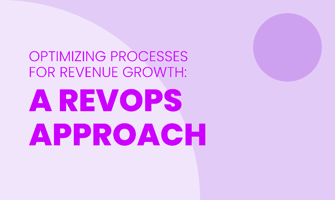Increasing revenue is a top priority for businesses aiming to grow and succeed. Revenue growth...
The Ultimate Guide to Revenue Operations: Maximizing Your Business's Revenue Potential
Revenue operations, often referred to as RevOps, has emerged as a transformative approach that aligns and optimizes the various functions within a company to maximize revenue potential.
By streamlining processes and enhancing collaboration between sales, marketing, and customer success teams, RevOps not only propels revenue growth but also improves customer satisfaction and operational efficiency. Understanding and implementing RevOps can revolutionize how your company approaches its operations, leading you to achieve unprecedented levels of success.
This comprehensive guide takes you through the essence of revenue operations: the definition, goals, benefits, and how it differs from traditional sales operations.
Understanding Revenue Operations
What Is Revenue Operations?
Revenue operations, or RevOps, is an integrated business function that aims to break down silos between departments and streamline operations across a company to increase revenue.
It involves coordination among the marketing, sales, and customer success teams to create a unified approach to the customer journey. By aligning goals, strategies, and processes, RevOps enhances the efficiency of operations and improves the bottom line.
At its core, RevOps is a strategic convergence of people, processes, systems, and data, with the primary focus of driving revenue growth. Interdepartmental collaboration is critical in RevOps as it allows a company to leverage the collective strengths of each team, ensuring that everyone is working towards the same revenue goals.
Be it through automation tools, CRM systems, or data analytics, RevOps connects the dots to provide a comprehensive picture of the business’s health and operational effectiveness.
What Is the Goal of Revenue Operations?
The principal goal of RevOps is to identify and capitalize on opportunities for revenue growth within an organization. By analyzing customer data, market trends, and internal processes, RevOps teams develop strategies to not only attract new customers but also retain existing ones, thereby maximizing the customer lifetime value.
Revenue operations focus on optimizing every step of the revenue generation process, from the first customer interaction to the final deal closure and beyond. Through system integration and seamless collaboration, RevOps aims to remove the operational roadblocks that often arise due to misaligned departments.
This ensures that every function within the business is operating cohesively towards shared objectives. Ultimately, RevOps fosters a culture of analysis, adaptability, and continual improvement, with the ultimate goal being the sustained growth and profitability of the company.
Importance of Revenue Operations
Why Does My Company Need RevOps?
In a climate where swift adaptability and customer-centricity are key to survival, your business can't afford to operate in silos. RevOps provides the blueprint for better cross-departmental coordination, allowing for more strategic decision-making that can adapt to rapid market changes. In essence, it equips your company with the agility needed to thrive in dynamic economies.
A well-structured RevOps framework transforms raw customer data into actionable insights, enabling companies to pinpoint what to sell and to whom. Implementing such a system lays the groundwork for sustained revenue acceleration and market responsiveness. This is where companies like 180ops, with their technological expertise, and business expertise become highly valuable, by offering sophisticated tools that can dissect and utilize data effectively for revenue growth.
What Are the Benefits of Implementing Revenue Operations?
The implementation of RevOps within your business can be game-changing, promising a multitude of benefits:
Enhanced Alignment and Collaboration: RevOps unites sales, marketing, and customer service teams, aligning their workflows and objectives to ensure a shared vision for revenue growth.
Streamlined Processes: By reframing the organizational structure around RevOps, companies can more efficiently manage their end-to-end operations from lead generation to customer retention.
Data-Driven Insights: A RevOps approach means a greater focus on analytics, data-driven informs strategic decision-making and identifies new opportunities for revenue expansion.
Increased Efficiency and Productivity: Automation and technology are pillars of RevOps, eliminating manual tasks and freeing teams to focus on more strategic initiatives.
Improved Customer Experience: A smoother operation across the board means a more cohesive customer journey, leading to increased satisfaction and loyalty.
Revenue Operations vs Sales Operations
While sales operations (Sales Ops) and revenue operations (RevOps) both aim to enhance the efficiency and effectiveness of a company's sales efforts, there's a distinction. Sales operations primarily focus on the optimization of the sales process itself. In contrast, RevOps looks at the bigger picture, integrating sales with marketing and customer success strategies to drive a unified approach to revenue.
RevOps extends beyond the sales funnel to encompass every touchpoint in the customer lifecycle, ensuring the business operates as a cohesive unit. This holistic approach fosters sustainable growth by aligning all revenue-related functions and strategically utilizing customer data, operational processes, and technology systems to drive revenue expansion.
Key Processes in Revenue Operations
![]()
Revenue Operations Strategy
Aligning Sales, Marketing, and Customer Success
Integration across departments ensures that the RevOps team is harmoniously aligned, paving the way for a seamless customer journey. From lead generation to closed deals and post-sale support, each team contributes to a consistent, singular revenue objective that is cognizant of the complete customer lifecycle.
Optimizing the Customer Journey for Revenue Growth
RevOps teams emphasize the importance of each touchpoint in the customer journey. They analyze and fine-tune interactions to ensure each stage is conducive to revenue growth. By understanding customer behavior and preferences through data, they can personalize and enhance the customer experience, ultimately boosting retention and lifetime value.
Financial Planning and Analysis
A RevOps strategy is not complete without thorough planning and analysis. In this stage, teams deploy tools to forecast revenue, set targets, and model the financial implications of business decisions. This helps in ensuring that all actions taken align with the overarching goal of revenue optimization.
Tech Stack Management
Technology is a catalyst in RevOps, and managing the tech stack effectively is critical. It includes selecting the right CRM, marketing automation, customer service tools and a RevOps or revenue intelligence tool that integrates all data and intelligence across different tools smoothly and provides the needed overviews to drive revenue operations.
Optimizing Sales Operations
Lead Management
Efficient lead management is key to a productive sales process. RevOps centralizes and analyzes lead data to ensure high-quality leads are prioritized and nurtured through targeted marketing and sales efforts.
Sales Process Optimization
RevOps streamlines the sales process from end-to-end, identifying bottlenecks and implementing strategies to increase close rates, reduce sales cycles, and enhance the overall productivity of the sales team.
Sales Enablement
Equip your sales team with comprehensive resources, training, and content that empowers them to engage effectively with buyers. RevOps ensures sales reps have the tools and knowledge to address customer needs and close more deals.
Improving Marketing Operations
Companies can drive better results in revenue generation by focusing on aligning marketing operations with sales and customer success departments through Revenue Operations.
Integrating the team, processes, and systems ensures a cohesive strategy across all customer touchpoints, from lead generation to customer retention.
Efficient customer data management and automation in marketing operations can enhance customer segmentation and targeting for more personalized and effective campaigns.
Streamlining data analytics facilitates better decision-making processes, enabling marketers to optimize strategies based on real-time insights.
RevOps teams can leverage tools like CRM software, HubSpot, and revenue intelligence systems to track customer journeys, improve customer satisfaction, and drive revenue growth.
By aligning functions and goals, RevOps optimizes business processes and helps achieve operational excellence.
Marketing Strategy and Execution
RevOps drives marketing effectiveness by ensuring strategy and execution are closely aligned with the sales and customer success functions. By understanding the full sales funnel and customer journey, marketing programs are designed to deliver quality leads and contribute to a cohesive buying experience.
Customer Segmentation and Targeting
To maximize the impact of marketing efforts, RevOps leads the way in utilizing customer data for precise segmentation and targeting. This tailored approach ensures that marketing resources are focused where they can generate the most revenue.
Data Management and Analytics
The backbone of successful marketing in a RevOps framework is data management and analytics. With the correct, holistic data, marketing operations can gain valuable insights into campaign performance, customer preferences, and market trends, thereby enabling informed decision-making and strategy refinement.
Boosting Customer Success Operations
To improve customer success, companies can do two things:
Optimize customer onboarding and support processes. This helps create a smooth experience for customers and boosts satisfaction and retention rates.
Implement efficient account management strategies and focus on customer expansion.
This involves analyzing customer data to identify opportunities for upselling and cross-selling, driving revenue growth.
Furthermore, aligning marketing, sales, and customer service functions can enhance collaboration, while automation tools and data analytics can streamline processes and lead to increased efficiency and revenue. Lastly, by structuring effective RevOps teams with designated roles, businesses can ensure long-term company growth and success through successful customer success operations.
Customer Onboarding and Support
A thorough onboarding process and consistent support are essential to customer satisfaction and retention. RevOps helps streamline these processes, ensuring customers realize the value of their purchase swiftly and support is readily available when issues arise.
Account Management and Expansion
RevOps also focuses on identifying opportunities for account growth. This includes upselling, cross-selling, and leveraging customer relationships to extend their lifetime value.
Customer Feedback Loop
Gathering and analyzing customer feedback is essential for continuous improvement. RevOps ensures that feedback is integrated into operational processes to enhance product offerings and customer service.
Technology and Systems Management
Revenue Operations involves various technologies and systems. These include CRM systems, automation tools, data analytics, and revenue intelligence software.
These tools help in managing customer data, aligning marketing and sales operations, and optimizing business processes within revenue operations teams.
CRM systems streamline customer interactions and track customer journey stages. Automation tools enhance efficiency by automating repetitive tasks and improving reporting capabilities.
By using these technologies, businesses can achieve success, drive revenue growth, and improve customer satisfaction throughout the customer journey.
These systems also play a key role in integrating departments, aligning strategies, and meeting revenue operations goals by providing insights into customer behavior and enhancing overall customer experience.
CRM and Automation Tools
RevOps relies on advanced CRM systems and automation tools to streamline tasks and personalize customer interactions. Properly configured, these tools enhance efficiency and free up the team to focus on strategy and growth.
Data Integration and Quality
Seamless data flow between systems ensures a single source of truth for revenue-related data. RevOps prioritizes data quality and integration to provide accurate insights crucial for decision-making.
Reporting and Analytics Infrastructure
RevOps teams require a strong analytics infrastructure to track performance and identify improvement areas. This involves setting up reporting systems that deliver actionable insights to all revenue-related functions.
Performance Measurement and Optimization
Companies can boost revenue by using analytics tools to analyze customer data, sales trends, and marketing strategies. This helps identify patterns and areas for improvement.
Continuous improvement in revenue operations is crucial. Establishing a feedback loop for evaluating processes, identifying bottlenecks, and implementing solutions is key.
Important metrics for measuring performance in revenue operations include customer acquisition cost, customer lifetime value, sales conversion rates, customer retention rates, and overall revenue growth. Tracking these metrics closely leads to informed decisions and improved efficiency.
Leveraging Data to Identify Revenue Opportunities
RevOps turns to in-depth data analytics to uncover hidden revenue opportunities within the business. By analyzing sales patterns, customer behavior, and market trends, the RevOps team can pinpoint areas ripe for expansion or improvement.
Continuous Process Improvement
In the spirit of agile methodologies, RevOps champions an iterative approach to operations, always looking for ways to refine and enhance processes. Whether it's tweaking the sales funnel or adjusting customer service protocols, there's a perpetual quest for perfection.
Building Your Revenue Operations Team
![]()
Essential Roles and Responsibilities
A competent RevOps team is a blend of diverse skills and roles intricately woven together. Critical positions within this team include data analysts, who explore and interpret customer and market data; system administrators, who oversee the CRM and other tech tools; and RevOps strategists, who design the revenue processes and ensure they align with business objectives. These core members work alongside marketing, sales, and customer success professionals to implement RevOps initiatives effectively.
Each member is responsible for bridging gaps between teams, streamlining communication, and optimizing their respective functions to support the company's revenue goals. The RevOps team needs a comprehensive understanding of the company's products, market positioning, and customer needs to drive strategies that support sustainable revenue growth.
Fostering Collaboration Across Departments
Building a strong RevOps team is more than just assembling skilled professionals; it is about fostering collaboration across marketing, sales, and customer service departments. RevOps champions a customer-centric culture where silos are broken down, and cross-department cooperation is the norm, not the exception.
Interdepartmental projects and regular communication between teams ensure that everyone understands the business's holistic goals, aligns with the established processes, and contributes to the collective success. It is this unified approach that enables businesses to respond quickly to market conditions and customer requirements, ultimately achieving operational excellence and increased profitability.
The Role of Data in Revenue Operations
How RevOps Utilizes Data
Data acts as the lifeblood of revenue operations, providing the insights needed to make informed decisions. By aggregating and analyzing customer data from various touchpoints—be it sales, marketing, or customer service— and enriching it with external data, RevOps teams can develop comprehensive profiles that inform targeted strategies. The insights derived from this data enable businesses to tailor their approach to different segments and optimize each stage of the customer journey.
Key Metrics for Revenue Operations
RevOps teams must stay focused on key performance indicators (KPIs) that accurately reflect the health and efficiency of revenue processes. These metrics can range from customer lifetime value (CLTV), customer acquisition costs (CAC), conversion rates, to churn rates. Keeping an eye on these metrics helps RevOps teams to measure success and pivot strategies as needed for better outcomes.
Collecting Data for RevOps
Various data sources are used when collecting Revenue Operations data. These sources may include:
Customer data from CRM systems
Sales funnel analytics
Marketing operations reports
Customer satisfaction surveys
External macroeconomic data
By using a mix of these data sources, the RevOps team can gain insights into customer behaviors, revenue trends, and operational efficiencies.
To ensure accurate data collection for Revenue Operations:
Implement data automation tools
Establish clear data governance processes
Align data reporting across sales, marketing, and customer service departments
Integrating these strategies into the RevOps team's processes can help companies make informed decisions for success based on reliable data.
Tools and Technologies for Revenue Operations
![]()
CRM Systems and Their Impact on Revenue Operations
Customer Relationship Management (CRM) systems are the technological backbone of effective revenue operations, enabling seamless data flow and customer tracking. By leveraging these systems, companies can ensure that all customer interactions are logged, analyzed, and utilized to improve the customer journey and drive sales growth.
Automation Tools to Enhance Efficiency
Automation is a key enabler in RevOps, reducing manual tasks, and allowing teams to focus more on strategic activities. Tools that enable automation—such as marketing automation platforms, email nurturing tools, and lead scoring systems—help businesses scale their operations while maintaining personalized customer experiences.
Analytics and Revenue Intelligence Tools for Data-Driven Decisions
To make decisions that are based on solid evidence, companies rely on analytics and revenue intelligence tools, like 180ops. These solutions process vast amounts of data to provide actionable insights, helping RevOps teams to understand performance metrics, identify improvements, and predict future trends.
Conclusion
Revenue Operations represent a significant shift in how companies pursue growth and operational excellence. It's an overarching strategy that integrates sales, marketing, and customer success efforts to drive revenue. The application of a robust RevOps framework, complemented by revenue intelligence tools like those provided by 180ops, can be the key that unlocks your company's untapped revenue potential.
By deploying AI and machine learning technologies, RevOps can dissect complex customer data, optimize processes, and create a seamless journey that delights customers at every turn. It's an investment in the efficiency and agility of your business, setting you up not just for immediate gains but also for long-term prosperity.
FAQ
What is revenue operations and why is it important for businesses?
Revenue operations, or RevOps, is a strategic approach that aligns a company’s marketing, sales, and customer success teams to drive optimal revenue growth. It's important for businesses as it fosters collaboration among these departments to streamline processes, optimize the customer journey, and make data-driven decisions, ultimately increasing efficiency and revenue.
How can implementing revenue operations strategies help maximize a business's revenue potential?
Implementing RevOps strategies can maximize a business's revenue potential by improving alignment between teams, enhancing the quality of customer interactions, and providing a clear framework for leveraging data and technology to uncover insights and opportunities.
What are the key components of successful Rev Ops?
The key components include a well-integrated technology stack, clear processes across marketing, sales, and customer success, a data-driven culture, and strong leadership that supports collaboration and strategic alignment.
How can businesses measure the success of their revenue operations efforts?
Businesses can measure the success of their RevOps efforts by tracking metrics such as conversion rates, customer acquisition costs, customer lifetime value, and revenue growth.
What are some common challenges businesses face when implementing revenue operations?
Common challenges include aligning different departments towards common goals, integrating various data sources and systems, and instilling a culture that embraces change and cross-functional collaboration.




